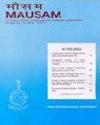利用风速作为动力和对数定律分析污染物的沉积浓度
IF 0.7
4区 地球科学
Q4 METEOROLOGY & ATMOSPHERIC SCIENCES
引用次数: 0
摘要
通过对平流-扩散方程进行分析求解,得出了空气中扩散粒子浓度的数学公式,其中考虑到:(1) 风速和涡流扩散率随地面高度的垂直变化。(2) 垂直扩散受到位于高度为 h 的大气边界层(ABL)顶部的高空不可穿透反转层的限制。幂律曲线用于描述涡扩散率随高度的垂直变化,而幂律曲线和对数定律之和用于描述风速随地面高度的垂直变化。得出了污染物沿风向的衰减距离。 在稳定条件下,根据汉福德扩散实验的数据集对本解决方案进行了评估。对结果进行了讨论,并给出了说明性数字。本文章由计算机程序翻译,如有差异,请以英文原文为准。
Analytical concentration of pollutants with deposition using wind speed as power and logarithmic law
The mathematical formulation of the concentration of the diffusing particles in air was derived by solving analytically the advection-diffusion equation taking into consideration: (1) the vertical variation of wind speed and eddy diffusivity with height above ground. (2) the vertical diffusion is limited by an elevated impenetrable inversion layer located at the top of the atmospheric boundary layer (ABL) of height h. (3) the dry deposition of the diffusing particles at the ground surface which was included through the boundary conditions. A power law profile is used to describe the vertical variation of eddy diffusivity with height, while the sum of power law profile and logarithmic law is used to describe the vertical variation of wind speed with height above ground surface. The decay distance of a pollutant along the wind direction was derived. The present solution was evaluated against the dataset from Hanford diffusion experiment in stable conditions. The results are discussed and presented in illustrative figures.
求助全文
通过发布文献求助,成功后即可免费获取论文全文。
去求助
来源期刊

MAUSAM
地学-气象与大气科学
CiteScore
1.20
自引率
0.00%
发文量
1298
审稿时长
6-12 weeks
期刊介绍:
MAUSAM (Formerly Indian Journal of Meteorology, Hydrology & Geophysics), established in January 1950, is the quarterly research
journal brought out by the India Meteorological Department (IMD). MAUSAM is a medium for publication of original scientific
research work. MAUSAM is a premier scientific research journal published in this part of the world in the fields of Meteorology,
Hydrology & Geophysics. The four issues appear in January, April, July & October.
 求助内容:
求助内容: 应助结果提醒方式:
应助结果提醒方式:


